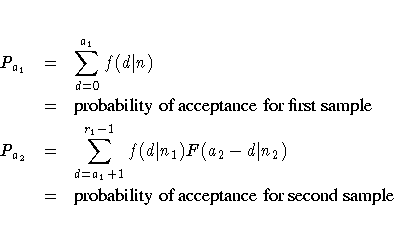Chapter Contents
Previous
Next
|
Chapter Contents |
Previous |
Next |
| Functions |
PROBACC2(a1,r1,a2,n1,n2,p)
where
| a1 | is the acceptance number for the first sample, where
|
| r1 | is the rejection number for the first sample, where r1>a1+1. |
| a2 | is the acceptance number for the second sample, where a2 > a1. |
| n1 | is the size of the first sample, where |
| n2 | is the size of the second sample, where |
| D | is the number of nonconforming items in the lot, where
|
| N | is the lot size, where |
| p | is the proportion of nonconforming items produced by the process, where 0<p<1. |
For either type of sampling plan, the acceptance probability is calculated as
where

and

These probabilities are determined from either the hypergeometric distribution (Type A sampling) or the binomial distribution (Type B sampling).
data;
prob=probacc2(1,4,3,50,100,10,200);
put prob;
run;
data;
prob=probacc2(0,2,1,13,13,0.18);
put prob;
run;
|
Chapter Contents |
Previous |
Next |
Top |
Copyright © 1999 by SAS Institute Inc., Cary, NC, USA. All rights reserved.